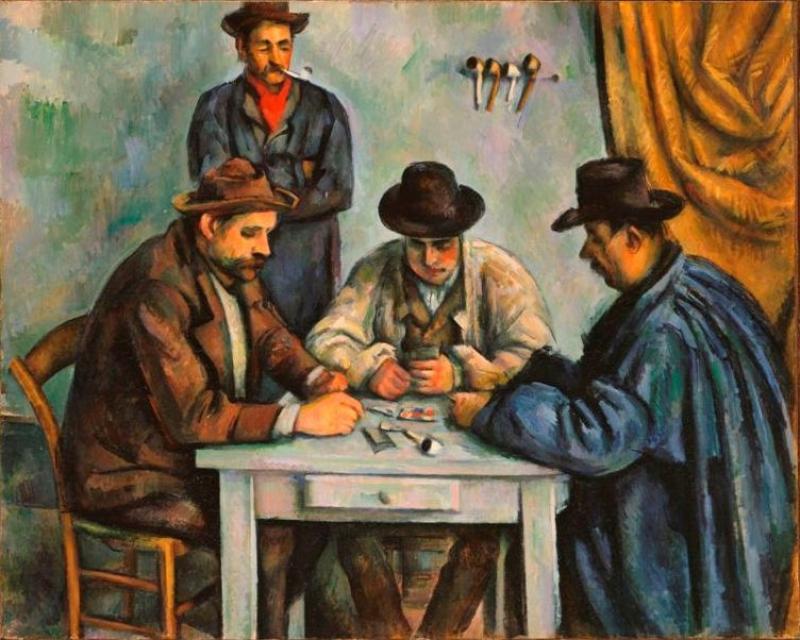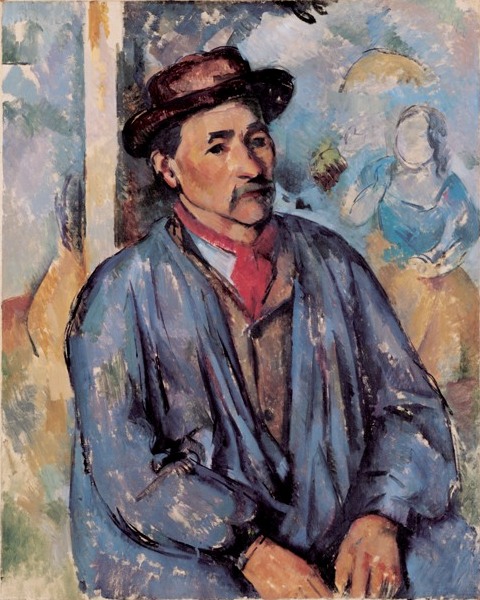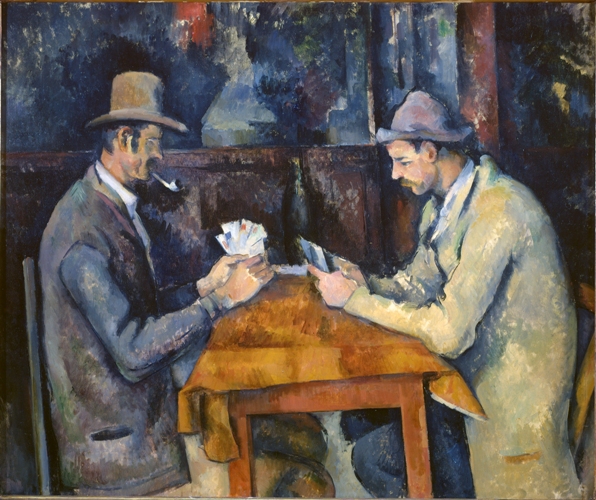Cézanne's Card Players, Courtauld Gallery | reviews, news & interviews
Cézanne's Card Players, Courtauld Gallery
Cézanne's Card Players, Courtauld Gallery
Cézanne's small but monumental series of paintings examined in depth

Give me a small side order of Cézannes over a great feast of Gauguins any day.
This approach, though limited by resources, easily competes with that of the flashiest blockbuster. What’s more, it’s an approach that frequently outdoes the big tub-thumbing surveys. And given the paintings on view in this exhibition, this is certainly the case with Cézanne’s Card Players.
 Along with a few supporting oil, watercolour and pencil sketches, Card Players boasts just a handful of finished paintings. They belong to Cézanne’s series of canvases produced between 1890 and 1896 and dedicated to the depiction of rural farm workers playing cards around a rustic table. It also includes a few of these characters – individuals known to Cézanne as workers on his Provençal estate, Jas de Bouffan - in individual poses (pictured right, Man in a Blue Smock).
Along with a few supporting oil, watercolour and pencil sketches, Card Players boasts just a handful of finished paintings. They belong to Cézanne’s series of canvases produced between 1890 and 1896 and dedicated to the depiction of rural farm workers playing cards around a rustic table. It also includes a few of these characters – individuals known to Cézanne as workers on his Provençal estate, Jas de Bouffan - in individual poses (pictured right, Man in a Blue Smock).
But though you might call Cézanne’s Card Players genre paintings, these are most unlike the animated tavern scenes depicted in 17th-century Dutch and French painting. They are remarkable for their stillness, for their sense of timelessness and simple but imposing monumentality. They certainly epitomise Cezanne’s aim to produce “something solid and endurable, like the art of the museums”.
As such, his peasants are as sturdy and impressive as the aged trunk of an oak tree; so solid and stoically still in appearance that they look as if they might have been carved in wood, their sun-browned features given no more attention to detail or scrutiny than the bottle on the table, or the collar of a shirt. And each part of the painting, regardless of object, is given equal weight, offering a dazzling study of painterly, patchwork surface, but, in the case of the human subject, nothing in the way of psychological penetration. As such, eyes are often as dark and as blank and impenetrable as pebbles. Like the naturalistic novels of his childhood friend Emile Zola, Cézanne was not interested in depicting his sitters as individuals with throbbing, complex inner lives, but as types, responsive only to their immediate environment.
 The first in the series of Card Players – though the exact chronology of the series is, in fact, disputed – is the canvas that is owned by the Metropolitan Museum of Art (main picture). It features four figures, three of which are seated, hunched over their game, with one figure standing, hovering over them in unresolved space. It’s the first painting that confronts you, bang in the middle of the wall facing the gallery entrance. And the thing that strikes you first are the colours, the powdery blue of the backdrop, the tawny gold of a rumpled curtain, the deep blue of a smock and a set of overalls, the latter offset by the fierce red of a scarf. No justice can be done to them in reproduction, but the colours are utterly seductive. What’s more there is little depth of field. And what’s so strange about this painting, when you examine it closely, is that, although the figures all appear so sculpted, so solid, there is little sense of how the hovering figure relates to the seated figures – he appears to have no spatial relationship to the room. Is he backed right against the wall or standing right next to the seated figures? The wall seems to envelop him in a rather ambiguous - though certainly not displeasing - but rather tantalising way.
The first in the series of Card Players – though the exact chronology of the series is, in fact, disputed – is the canvas that is owned by the Metropolitan Museum of Art (main picture). It features four figures, three of which are seated, hunched over their game, with one figure standing, hovering over them in unresolved space. It’s the first painting that confronts you, bang in the middle of the wall facing the gallery entrance. And the thing that strikes you first are the colours, the powdery blue of the backdrop, the tawny gold of a rumpled curtain, the deep blue of a smock and a set of overalls, the latter offset by the fierce red of a scarf. No justice can be done to them in reproduction, but the colours are utterly seductive. What’s more there is little depth of field. And what’s so strange about this painting, when you examine it closely, is that, although the figures all appear so sculpted, so solid, there is little sense of how the hovering figure relates to the seated figures – he appears to have no spatial relationship to the room. Is he backed right against the wall or standing right next to the seated figures? The wall seems to envelop him in a rather ambiguous - though certainly not displeasing - but rather tantalising way.
Whether Cézanne himself saw this as a problem is unclear, but the two later group paintings (pictured above left, the Courtauld-owned Card Players) appear to resolve this ambiguity. Tonality largely replaces colour and two figures are lost, so that we have only two remaining figures, hunched across each other at a table, each lost to the contemplation of their cards. What these paintings lose in colour, they appear to gain in uncluttered architectural monumentality, and to gain further that sense of the timeless that Cézanne strove to achieve. It is not only wonderful to be afforded the space to appreciate each of these great paintings carefully in turn, but to appreciate in such depth Cézanne’s development over this one series.
- Cézanne’s Card Players at the Courtauld Gallery until 16 January, 2011
Share this article
The future of Arts Journalism
You can stop theartsdesk.com closing!
We urgently need financing to survive. Our fundraising drive has thus far raised £49,000 but we need to reach £100,000 or we will be forced to close. Please contribute here: https://gofund.me/c3f6033d
And if you can forward this information to anyone who might assist, we’d be grateful.

Subscribe to theartsdesk.com
Thank you for continuing to read our work on theartsdesk.com. For unlimited access to every article in its entirety, including our archive of more than 15,000 pieces, we're asking for £5 per month or £40 per year. We feel it's a very good deal, and hope you do too.
To take a subscription now simply click here.
And if you're looking for that extra gift for a friend or family member, why not treat them to a theartsdesk.com gift subscription?
more Visual arts
 'We are bowled over!' Thank you for your messages of love and support
Much-appreciated words of commendation from readers and the cultural community
'We are bowled over!' Thank you for your messages of love and support
Much-appreciated words of commendation from readers and the cultural community
 Folkestone Triennial 2025 - landscape, seascape, art lovers' escape
Locally rooted festival brings home many but not all global concerns
Folkestone Triennial 2025 - landscape, seascape, art lovers' escape
Locally rooted festival brings home many but not all global concerns
 Sir Brian Clarke (1953-2025) - a personal tribute
Remembering an artist with a gift for the transcendent
Sir Brian Clarke (1953-2025) - a personal tribute
Remembering an artist with a gift for the transcendent
 Emily Kam Kngwarray, Tate Modern review - glimpses of another world
Pictures that are an affirmation of belonging
Emily Kam Kngwarray, Tate Modern review - glimpses of another world
Pictures that are an affirmation of belonging
 Kiefer / Van Gogh, Royal Academy review - a pairing of opposites
Small scale intensity meets large scale melodrama
Kiefer / Van Gogh, Royal Academy review - a pairing of opposites
Small scale intensity meets large scale melodrama
 Jenny Saville: The Anatomy of Painting, National Portrait Gallery review - a protégé losing her way
A brilliant painter in search of a worthwhile subject
Jenny Saville: The Anatomy of Painting, National Portrait Gallery review - a protégé losing her way
A brilliant painter in search of a worthwhile subject
 Abstract Erotic, Courtauld Gallery review - sculpture that is sensuous, funny and subversive
Testing the boundaries of good taste, and winning
Abstract Erotic, Courtauld Gallery review - sculpture that is sensuous, funny and subversive
Testing the boundaries of good taste, and winning
 Edward Burra, Tate Britain review - watercolour made mainstream
Social satire with a nasty bite
Edward Burra, Tate Britain review - watercolour made mainstream
Social satire with a nasty bite
 Ithell Colquhoun, Tate Britain review - revelations of a weird and wonderful world
Emanations from the unconscious
Ithell Colquhoun, Tate Britain review - revelations of a weird and wonderful world
Emanations from the unconscious
 Rachel Jones: Gated Canyons, Dulwich Picture Gallery review - teeth with a real bite
Mouths have never looked so good
Rachel Jones: Gated Canyons, Dulwich Picture Gallery review - teeth with a real bite
Mouths have never looked so good
 Yoshitomo Nara, Hayward Gallery review - sickeningly cute kids
How to make millions out of kitsch
Yoshitomo Nara, Hayward Gallery review - sickeningly cute kids
How to make millions out of kitsch
 Hamad Butt: Apprehensions, Whitechapel Gallery review - cool, calm and potentially lethal
The YBA who didn’t have time to become a household name
Hamad Butt: Apprehensions, Whitechapel Gallery review - cool, calm and potentially lethal
The YBA who didn’t have time to become a household name

Add comment